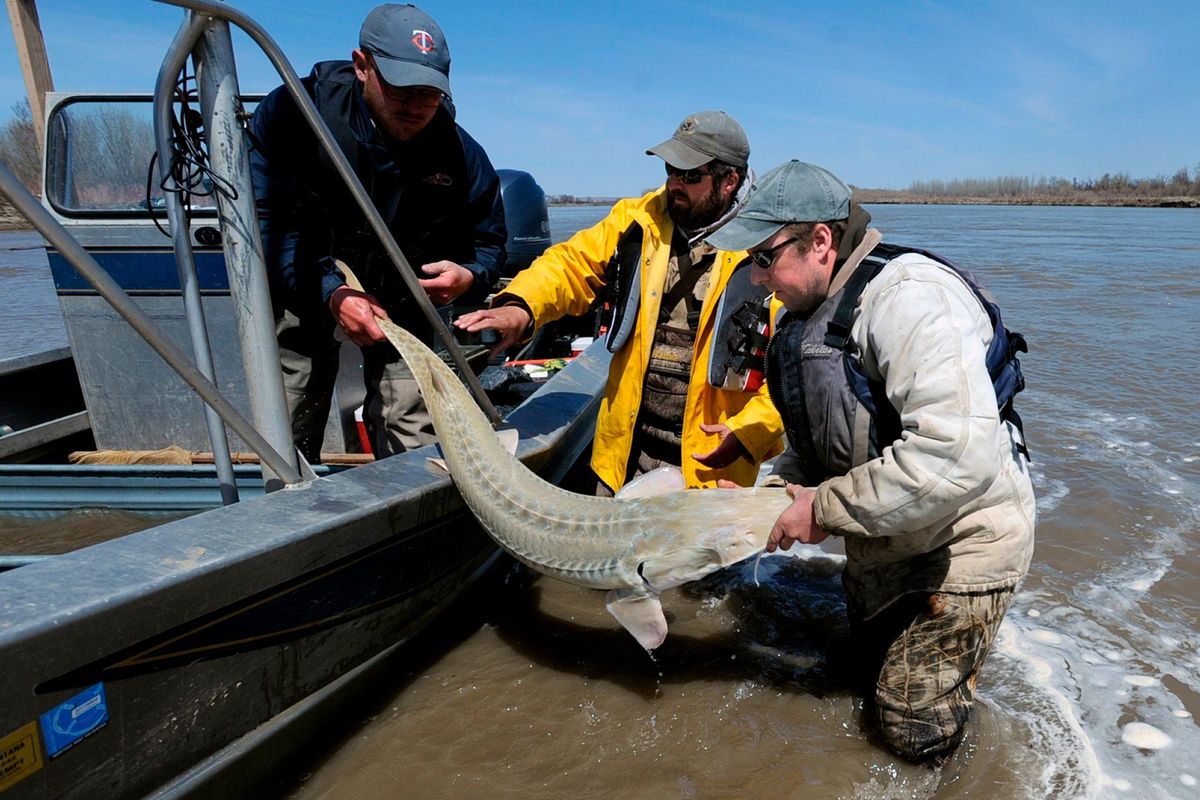Study: super-sizing sturgeon
In this 2014 photo, Montana Fish, Wildlife and Parks employees Dave Fuller, Chris Wesolek, and Matt Rugg release a pallid sturgeon after taking blood samples from the fish. In a novel study, Idaho fisheries biologists are attempting to accelerate the growth of some sturgeon by relocating them from Hells Canyon downstream to Lower Granite Reservoir on the Snake River. (James Woodcock)
In a novel study, fisheries biologists are attempting to speed the growth of some Hells Canyon sturgeon and thereby establish a tool that could help sustain or expand the population of the long-lived fish.
Sturgeon can reach ages that rival some older humans, and it can take them decades to reach spawning size – about 7 feet for females. Their growth rate is dependent in part on the availability of food and competition for that food.
Biologists for the Idaho Department of Fish and Game, Idaho Power and the Nez Perce Tribe have tracked Snake River sturgeon populations in a long-running monitoring project. They documented that juvenile fish living in Hells Canyon tend to grow much slower that those living in Lower Granite Reservoir west of Lewiston.
Fish less than 40 inches grow 2-4 inches per year in the reservoir but less than 1 inch per year in Hells Canyon. At that rate, it can take 50 years for a fish to reach spawning size. But some sturgeon in high-density pools in the canyon are growing much slower – only about a 10th of an inch per year.
“At that rate they will never grow out of the growth bottleneck and just die before they ever reach sizes (at which) they will spawn,” Joe DuPont, regional fisheries manager for the Idaho Department of Fish and Game at Lewiston.
Once sturgeon reach 40 inches, the growth rate of the Hells Canyon fish steadily increases and eventually matches that of fish in the reservoir.
So biologists from the department and Idaho Power are undertaking a pilot study to determine if they can increase the number of spawners in the population by moving some slow-growing fish living in deep, high-density sturgeon pools in Hells Canyon to the reservoir where growth rates are much better and fish densities are lower.
This fall, they captured 80 juvenile sturgeon from three pools in the canyon and implanted them with tracking tags. Of those, 55 were moved downstream. The rest were released where they were caught.
Some of the fish caught for the experiment had been previously caught and tagged as part of an ongoing monitoring program. DuPont said five of those had annual growth rates of just millimeters. They also documented that fish living in different pools have different growth rates and those in the most crowded pools are growing the slowest.
The biologists will track movements of the fish and recapture as many as they can to monitor their growth rates. DuPont said some answers will come quickly and others will take some time.
“One, did most of those fish stay or did most of them leave? If we want this to be a tool in the future and 80% of fish leave, it’s probably not that great of a tool,” he said. “Two, if they stay, will they experience a growth spurt even if they are decades old?”
Even though the reservoir seems to humans to be a better place for the smaller fish, the sturgeon might not see it that way. There may be something upstream they like or the fish may simply be pulled there by some genetic signal to migrate.
DuPont said some of them may have already spent time in the reservoir. Sturgeon are broadcast spawners. Females release their eggs, males fertilize them, and the eggs sink and stick to rocks in fast-moving water. When they hatch, the larva drift and go wherever the current takes them. Many are flushed far downstream. But at some point in their lifetime, the fish move back upstream. When and why is little understood.
“These fish have always gone through a larval drift stage and before dams some of these fish went 100 miles, and if they didn’t have the urge to migrate upstream, they would all be downriver.”
If they stay, DuPont said it may take some of the relocated fish only a year or two to push past that 40-inch mark where they tend to grow at the same rate whether they live in the reservoir or the canyon.
The number of fish that stay and grow will help determine if moving younger sturgeon is a viable tool in managing the population.


